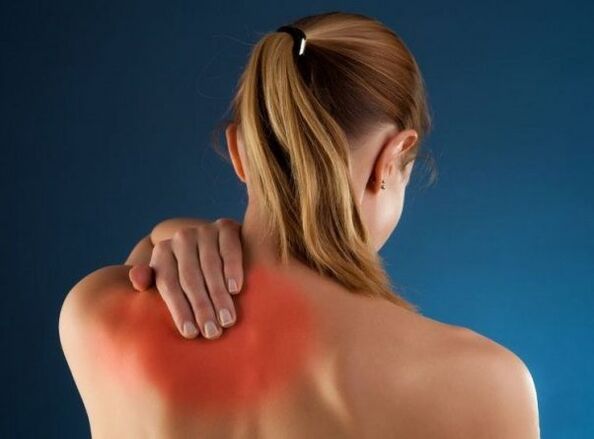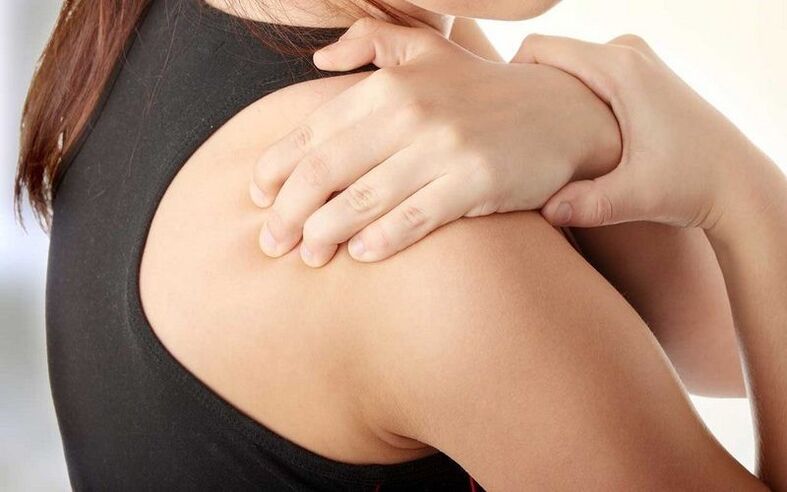
Back pain in the shoulder blade area is a very common complaint in patients of all ages. Such a problem affects breathing and creates serious obstacles in physical activity, work or simple movements.
Patients rarely pay attention to recurrent pain in the shoulder blades. However, this symptom is a "wake-up call" of serious changes not only in the musculoskeletal system, but also in the internal organ complex. Such conditions can threaten the patient with disability and death.
Next, the most common causes of pain in the shoulder blades and modern therapy techniques will be considered.
The most common reasons
The shoulder blades are located on the back of the back in close proximity to the humerus and collarbone. These paired bones, which are triangular in shape, are part of the frame to which the muscles responsible for shoulder mobility are attached. Because of this, back pain in the area of the shoulder blades interferes with normal life, affects the ability to work and poses a serious threat to health.
Why does the back hurt in the shoulder blade area? According to medical statistics, such problems are most often caused by injuries and damage to the elements of the cervical and thoracic spine. Severe pain syndrome can be observed due to pathological changes provoked by scoliosis or osteochondropathy, as well as for the following reasons:
- diseases of the cardiovascular system;
- intercostal neuralgia;
- scapulohumeral periarthritis;
- herniated disc in the thoracic spine;
- deforming spondylarthrosis;
- scoliosis, kyphoscoliosis and other curvatures of the spine;
- Failure of one or two kidneys.
If the back hurts in the area of \u200b\u200bthe shoulder blades, the causes can be diseases, tumors and injuries of the mediastinal organs, herpes zoster, intercostal neuralgia, impaired liver function, various pathologies of the pleura and lungs, such as, as well as long-term exercise of monotonous activities against the backgroundchronic ailments. At risk are drivers, clerks, seamstresses and representatives of other professions associated with staying in one position for a long time.
Pain in the back on the left and below the shoulder blades
Back pain below the shoulder blades often occurs due to osteochondrosis, various forms of stooping and scoliosis. If an adolescent has a disturbed physiological attitude, he needs a comprehensive diagnosis, well-chosen prevention and therapy. Otherwise, he can develop difficult-to-treat pathologies and deformities, disrupting normal life.
Pain in the spine associated with the causes listed above usually manifests itself in the form of severe discomfort that occurs after physical exertion. Scoliosis and other curvatures of the spine are preferably treated with massage, as well as manual and osteopathic influences. Pain syndrome localized in the area of \u200b\u200bthe left shoulder blades is a serious danger, since such symptoms can indicate an attack of angina and the development of coronary artery disease.
If pain in the left back in the area of the shoulder blades is accompanied by increased fatigue, shortness of breath, weakness and slight swelling of the face and ankles, you should immediately consult a doctor. Another cause of pain on the left shoulder blade can be a herniated disc. At risk are people who are forced to be in an uncomfortable position for a long time, drive a vehicle or work at a computer.
If the pain is only slightly annoying, you can limit yourself to the use of an ointment with a warming or analgesic effect, but if it worsens, the patient is advised to stay in bed.
Treatment of intervertebral hernias of the thoracic region includes the method of traction traction, manual therapy, reflexology, exercise therapy and a course of therapeutic massage. Drug methods of treating such pathologies are currently unknown to conservative medicine. With surgical intervention, the probability of a positive result is relatively small, about 30-35%.
At the same time, many patients relapse after a period of 10 months to several years.
Pain in the back muscles under the shoulder blades and in one shoulder blade
Pain in the muscles between the shoulder blades is usually observed in professional athletes engaged in weightlifting and in people subjected to high levels of physical exertion due to their activities. Causes of muscle pain between the shoulder blades can be:
- various injuries and bruises;
- stretching of the tendons;
- Overexertion when working or exercising at the gym.
If one scapula hurts badly, the pathology can be triggered by myopathy, neuroinfection, paralysis of the anterior serratus, trapezius or rhomboid muscles, various deformities of the shoulder joints, tuberculosis of the scapula or osteomyelitis, which led to the development of suppuration and intoxication of the body.
gastric ulcer
Pain syndrome localized in the area of \u200b\u200bthe shoulder blades often indicates the presence of such a dangerous disease as peptic ulcer. In such a case, discomfort and discomfort can spread along the thoracic spine and extend to the nipple and scapula on the left side. The pain gradually increases and is characterized by seasonality and periodicity, subsided by vomiting after emptying the contents of the stomach. In addition, most patients suffer from symptoms such as belching, salivation and heartburn.
That is interesting! With the perforation of the peptic ulcer even with little activity, the discomfort increases sharply, and to get rid of it the patient has to take a forced position on his back or right side, pressing his hips against his stomach. This phenomenon is accompanied by increased excitement, attacks of anxiety, as well as an unbearable pain syndrome radiating to the area above the collarbone.
Abscesses and muscle spasms of the bile ducts
Cutting and stabbing pains on the right side just below the shoulder blades are often caused by blockages of bile duct stones. As a result, there are colic, severe pain syndrome and the following symptoms:
- the presence of "tearing" sensations in the right hypochondrium;
- sudden attack of pain;
- nervousness, irritability;
- Pain radiating to the eyes, jaw, neck and right shoulder.
The pain syndrome localized above the waist in the region of the right shoulder blade may be due to a subdiaphragmatic abscess, which is characterized by very strong discomfort when breathing in, increased body temperature and pain radiating to the right shoulder. With an inflammatory process in the kidneys (nephritis, pyelonephritis), there is pain in the area of the right shoulder blade and lower back with frequent urination, which leads to a number of painful sensations.
mental problems
Pain in the spine between the shoulder blades is often triggered by various psychological problems. In such a case, the complaints are usually accompanied by the following symptoms:
- feeling short of breath;
- lump in the throat;
- paranoid thoughts, unmotivated fear;
- the appearance of cold tremors and heat in the chest;
- Feeling of pressure, heaviness and tightness.
In the case of psychological problems, there is often the unpleasant feeling that the heart is "bleeding" or jumping out of the chest, and the back in the area of the shoulder blades is also burning. Many patients suffer from ice-cold tremors, inner excitement and restlessness, up to and including panic attacks.
Intercostal neuralgia and osteochondrosis of the cervical region
Pain localized under the shoulder blade with intercostal neuralgia has a paroxysmal belt character and intensifies with palpation, physical activity, walking and coughing fits. In some cases, such symptoms are accompanied by excessive muscle tension, there is also a burning sensation, tingling and loss of sensitivity.

In osteochondrosis and ankylosing spondylitis, the pain syndrome often worsens at night, depriving the patient of sleep and causing great muscle tension in the morning.
With osteochondrosis of the cervical spine, the following symptoms are observed:
- Dizziness;
- increased pain when sharply bending or stretching the neck;
- paresthesias in the area of the shoulder girdle;
- Pain radiating to the arm or head.
Osteochondrosis can be recognized by one-sided dull pain in the back of the head. The discomfort usually increases in the morning, provoking an early awakening and causing many problems for the patient. To relieve an attack of cervical osteochondrosis, a warm bath or various drugs are used, which are selected exclusively as directed by a doctor.
During pregnancy
In women during pregnancy, the load on the spine increases, so a significant percentage of expectant mothers complain of back pain, including in the area of the shoulder blades. Cramping and burning pains, as well as numbness in the area of \u200b\u200bthe shoulder blades are often accompanied by changes in the hormonal background, which also affects the exacerbation of chronic diseases such as osteochondrosis.
For prevention, some doctors recommend that women wear a supportive corset in the late trimesters of pregnancy and a bandage after childbirth, which reduces stress on the spine and allows the child to maintain the correct position.
Different reasons
Back pain in the shoulder blades can be caused by angina or myocardial infarction. Pain syndrome most often occurs against the background of intense physical exertion and has a twisting-eversional character. Unpleasant sensations are common in the upper left half of the body, and getting rid of them with the help of drugs with a vasodilator effect will not work.
In such a case, it is necessary to eliminate negative symptoms in a clinical hospital, where the patient will be prescribed specially selected narcotic analgesics and supportive drugs.
diagnosis and treatment
Before taking any steps to eliminate the pain syndrome localized in the area of \u200b\u200bthe shoulder blades, you need to establish the cause of the pathology that has arisen. With aching back pain between the shoulder blades, accompanied by pulling and twisting, and baking and burning in the chest, you should immediately consult a doctor. The doctor will choose the best diagnostic method, such as:
- x-ray of the chest and spine;
- Ultrasonic;
- Electrocardiogram;
- CT scan.
Manual therapy in many cases shows positive results and allows you to strengthen both the lumbar and upper back and make the muscle tissue that supports the spine more elastic. Osteopathy and foot reflexology help to activate regeneration processes and the local metabolism. It is worth regularly strengthening muscles by performing an individually selected set of physical therapy exercises.

































